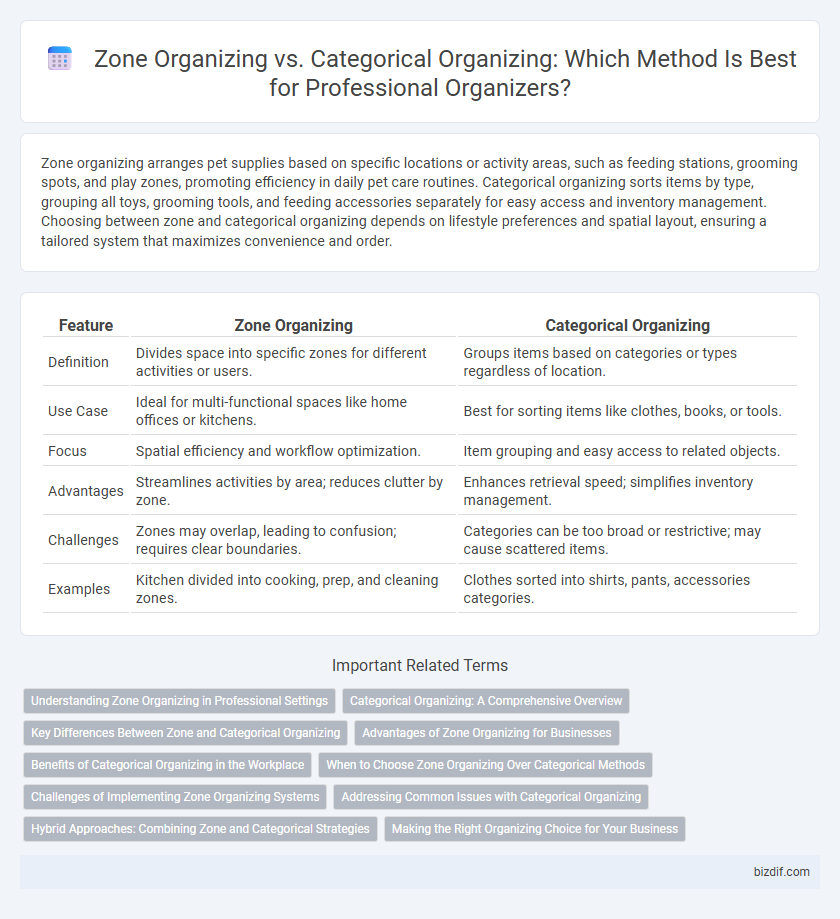Zone organizing arranges pet supplies based on specific locations or activity areas, such as feeding stations, grooming spots, and play zones, promoting efficiency in daily pet care routines. Categorical organizing sorts items by type, grouping all toys, grooming tools, and feeding accessories separately for easy access and inventory management. Choosing between zone and categorical organizing depends on lifestyle preferences and spatial layout, ensuring a tailored system that maximizes convenience and order.
Table of Comparison
| Feature | Zone Organizing | Categorical Organizing |
|---|---|---|
| Definition | Divides space into specific zones for different activities or users. | Groups items based on categories or types regardless of location. |
| Use Case | Ideal for multi-functional spaces like home offices or kitchens. | Best for sorting items like clothes, books, or tools. |
| Focus | Spatial efficiency and workflow optimization. | Item grouping and easy access to related objects. |
| Advantages | Streamlines activities by area; reduces clutter by zone. | Enhances retrieval speed; simplifies inventory management. |
| Challenges | Zones may overlap, leading to confusion; requires clear boundaries. | Categories can be too broad or restrictive; may cause scattered items. |
| Examples | Kitchen divided into cooking, prep, and cleaning zones. | Clothes sorted into shirts, pants, accessories categories. |
Understanding Zone Organizing in Professional Settings
Zone organizing divides a space into distinct areas based on function, enhancing efficiency by grouping related items together for specific activities. This method streamlines workflows in professional settings by reducing time spent searching for tools or documents within designated zones. Compared to categorical organizing, which sorts items by type, zone organizing aligns spatial arrangement with daily tasks, improving productivity and ease of access.
Categorical Organizing: A Comprehensive Overview
Categorical organizing involves grouping items by type or purpose, such as kitchen utensils, office supplies, or clothing, enhancing accessibility and streamlining maintenance. This method minimizes decision fatigue by allowing users to locate and return items within defined categories, leading to sustained organization. Employing categorical organizing supports efficient inventory management and simplifies decluttering by highlighting category-specific redundancies and necessities.
Key Differences Between Zone and Categorical Organizing
Zone organizing divides spaces based on specific areas or rooms, enabling targeted organization by physical location and improving workflow within designated zones. Categorical organizing, by contrast, groups items according to their function or type, such as clothes, documents, or tools, simplifying retrieval and reducing redundancy across spaces. Key differences include spatial focus in zone organizing versus item/function-driven grouping in categorical, affecting the overall approach to decluttering and maintenance strategies.
Advantages of Zone Organizing for Businesses
Zone organizing streamlines workflows by dividing workspaces into function-specific areas, enhancing employee efficiency and reducing time spent locating materials. This method promotes better spatial utilization, enabling businesses to maximize office layout and storage solutions. Improved task focus and minimized distractions result in higher productivity and seamless collaboration among teams.
Benefits of Categorical Organizing in the Workplace
Categorical organizing in the workplace streamlines task management by grouping related items, documents, or tools based on function, which enhances efficiency and reduces time spent searching for resources. This method supports clearer workflows and easier collaboration among teams, as employees can quickly locate and share relevant materials within specific categories. Implementing categorical organizing also minimizes clutter and improves overall office aesthetics, contributing to a more productive and stress-free work environment.
When to Choose Zone Organizing Over Categorical Methods
Zone organizing is ideal when managing multi-use spaces that require functional areas for specific activities, such as a home office combined with a living room. This approach enhances efficiency by grouping related items based on their location rather than item type, making it easier to maintain order in frequently used zones. Choose zone organizing when spatial functionality and ease of access outweigh strict item categorization.
Challenges of Implementing Zone Organizing Systems
Implementing zone organizing systems poses challenges such as difficulty in maintaining clear boundaries between zones, leading to potential overlap and confusion. The need for consistent labeling and user discipline is critical to prevent items from being misplaced, which can reduce the system's overall effectiveness. Additionally, adapting zone organizing to varying room sizes and functions often requires customized solutions, complicating standardization and long-term maintenance.
Addressing Common Issues with Categorical Organizing
Categorical organizing often leads to misplaced items when categories become too broad or overlapping, causing inefficiency and frustration. Zone organizing resolves this by grouping items based on their functional use within specific areas, enhancing accessibility and reducing search time. Implementing zone organizing addresses common categorical pitfalls such as clutter accumulation and difficulty maintaining order.
Hybrid Approaches: Combining Zone and Categorical Strategies
Hybrid organizing approaches merge zone organizing, which designates specific physical areas for items, with categorical organizing that groups similar items regardless of location. This method enhances efficiency by leveraging spatial clarity while maintaining the benefits of categorization, improving retrieval speed and minimizing clutter. Incorporating both strategies tailors organization systems to individual preferences and varied item types, boosting overall functionality and sustainability.
Making the Right Organizing Choice for Your Business
Zone organizing enhances workflow efficiency by dividing spaces into function-specific areas, ideal for businesses with varied operational zones. Categorical organizing groups items by type or use, streamlining inventory management and simplifying product retrieval. Choosing the right method depends on your business model, operational needs, and the nature of tasks to optimize productivity and reduce clutter.
zone organizing vs categorical organizing Infographic

 bizdif.com
bizdif.com